
Mini Masterclass. Sixgenerations of feisty British buzzbombs. Fastest Minis on test From Cooper to ERA Turbo, we drive a sextet of Minis with extra poke. 40 years of fun. After gathering six hot Minis spanning four decades, Simon Charlesworth holds on tight and goes from Cooper to ERA Turbo and back.
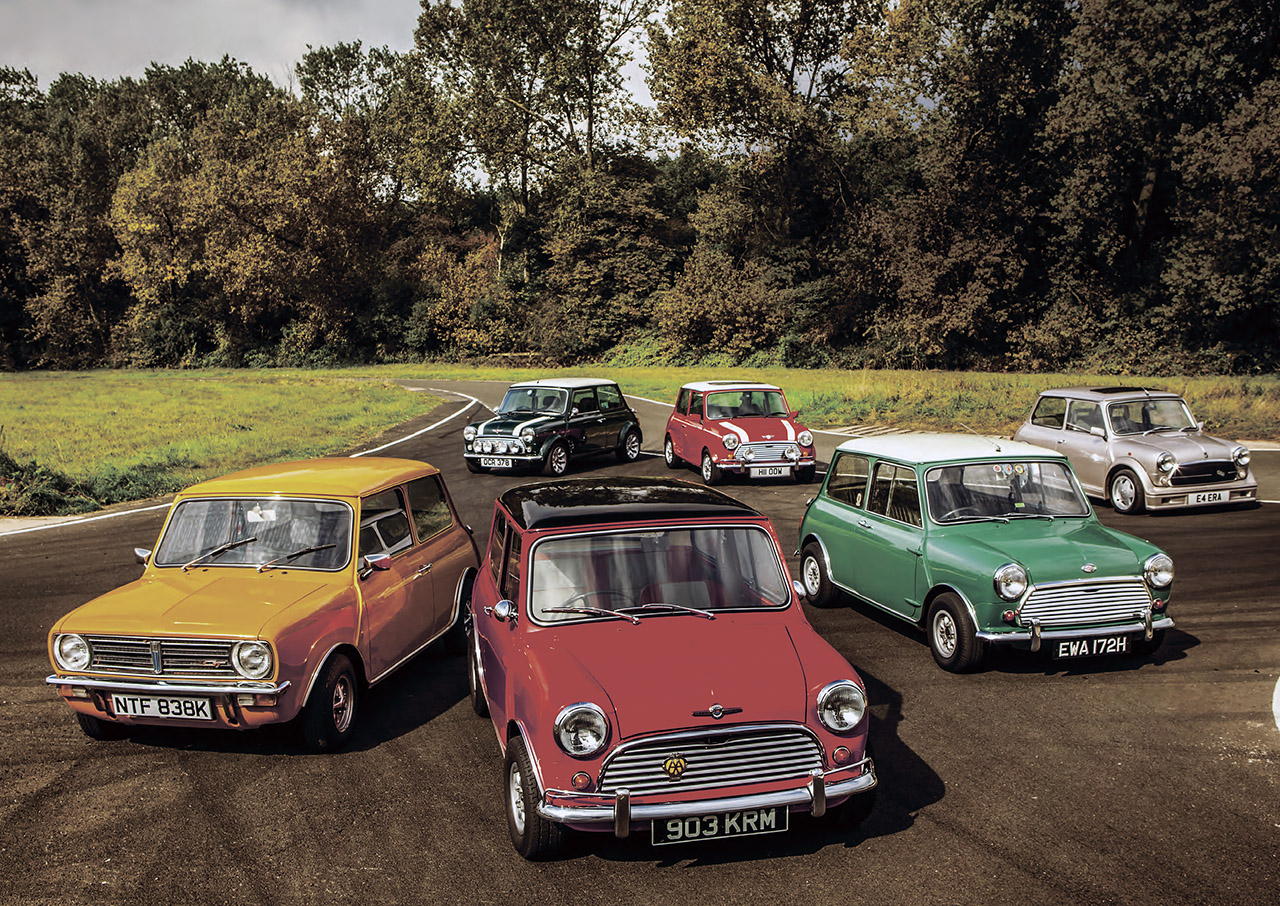
What could be better than a Mini? A car that, in 1999, Drive-MY users – plus a panel of experts – honoured as ‘the greatest of all time’. A marvel of packaging so smothered in plaudits that its status has risen from runabout to something closer to a constituent of British folklore. The answer? A quick Mini. Once BMC’s belittler of bubble cars was on the loose, it was but a blink before the 10ft marvel ventured onto racetracks and rally stages. Its handling prowess took even its designer Alec Issigonis by surprise: “A low centre of gravity, good weight distribution, and suspension which comes near to the theoretical ideal led us to hope for exceptional handling qualities – but the results exceeded expectations.”
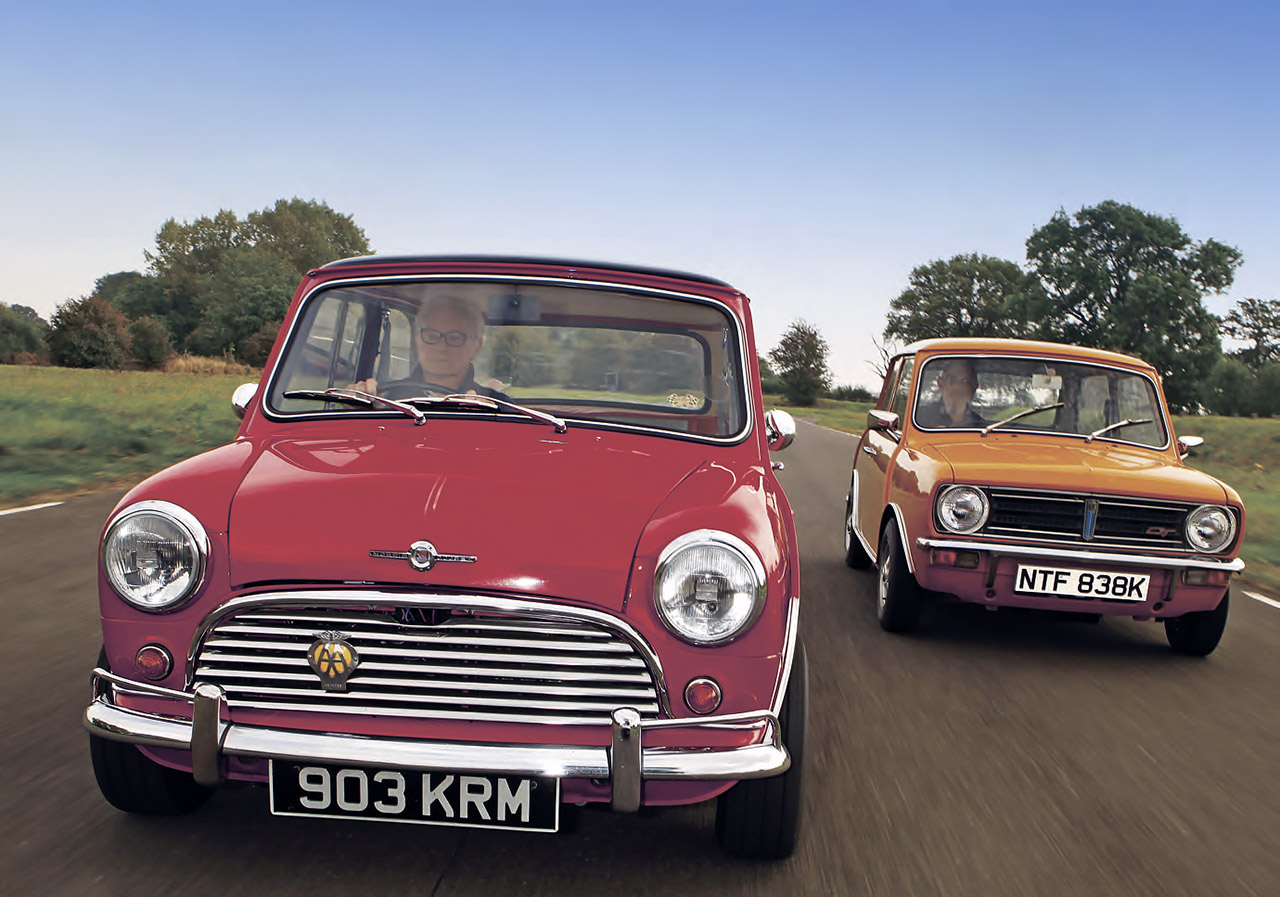
Here, ready to lure the unsuspecting into a minefield of references to The Italian Job are the various breeds of officially sanctioned quick Mini; a concept that would be revisited by the car’s parent company almost as frequently as it would change its name.
Among those inspired by the new car’s early motorsport forays was John Cooper. In addition to revolutionising post-war Grand Prix racing, Cooper had experience in both international Formula Junior and modified road cars, in the shape of a Climax-powered Renault Dauphine. Cooper saw the Mini’s potential, and it just so happened that his Formula Junior cars were powered by works A-series units.
‘THE COOPER IS ALL ABOUT BUILDING, MAINTAINING, AND DANCING WITH SPEED’
He got hold of a former press demonstrator, to which was initially fitted a 100bhp 948cc A-series and 7in Lockheed front disc brakes. After experimenting with a 994cc unit, Morris Engines’ Eddie Maher settled on a 55bhp 997cc with a modified cylinder head and cam profile, large inlet valves, higher compression ratio and twin SU HS2 carburettors. The car went down a storm with all who drove it.
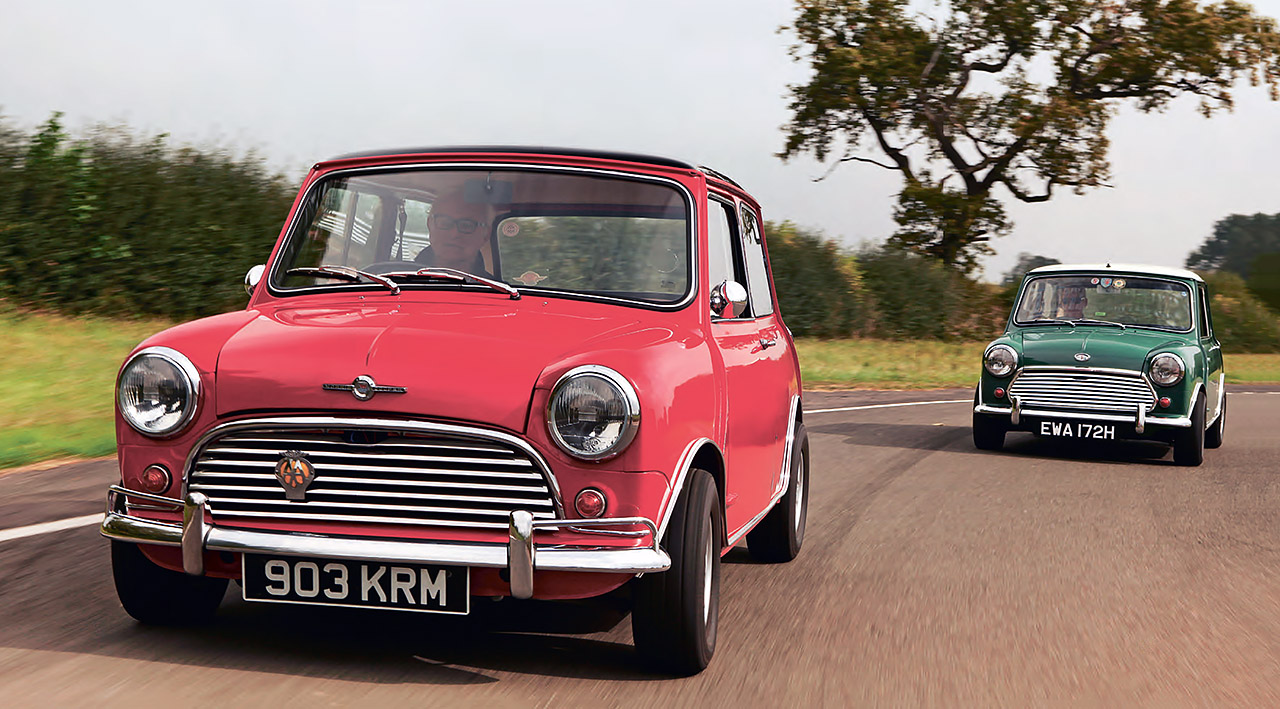
Cooper (left) and ‘S’ handle beautifully, with great roadholding. Below: twin carbs for both models – ‘S’ is 1275cc variant; familiar, well-packaged interior; 10in Minilite wheels; Morris badging.
Yet the notion of a quick Mini being officially offered via BMC’s showrooms very nearly didn’t happen. When Cooper approached Issigonis, who was technical director of Morris Engines, with a request to build a homologation run of 1000 cars, he was refused. The decision was only overturned by Cooper persuading Issigonis’ equally doubtful boss, Sir George Harriman, to build the car in July 1961. They paid John a royalty of £2 per Cooper sold.
In a worrying demonstration of how disconnected BMC management had become from the market, far from struggling to shift 1000 of them, 24,860 had been sold by the end of 997cc production in 1964. A-series rationalisation meant that the engine was superseded by the shorter-stroke 998cc unit at the end of 1963. In September 1964, Hydrolastic suspension replaced the original solid rubber cone set-up; this expensive and arguably less convincing system would last until the final MkIII Cooper ‘S’ was built in mid-1971. In October 1967, BMH introduced the MkII Mini, which featured a raft of tweaks – but it would last only until BLMC dropped the lesser Cooper in late 1969.

Lesser Cooper? Since 1962, the racing team had been running an 1100cc A-series in its Formula Junior T59. A rev-limit of 7800rpm and power of 98bhp was deemed a trifle hot for a road car, so was cooled down by Maher. Launched in April 1963, the Cooper ‘S’ – with its 70bhp 1071cc unit – gave the Mini a useful boost in Group One racing.
In March 1964, BMC replaced the 1071cc ‘S’ with the 65bhp 970cc variant that was launched alongside the final and fastest ‘S’ – the 75bhp 1275cc. This ultimate evolution would be the only Cooper to be produced post-March 1970 as a MkIII – in a 15-month, 1570-car run – before BLMC axed its UK association with Cooper. By then, the ‘S’ had competition from a younger-looking sibling in the form of the lower-priced, slower-paced 59bhp 1275 GT. Arguably more of a replacement for the Cooper than the ‘S’, the GT’s 1275cc capacity made comparisons with the latter inevitable.
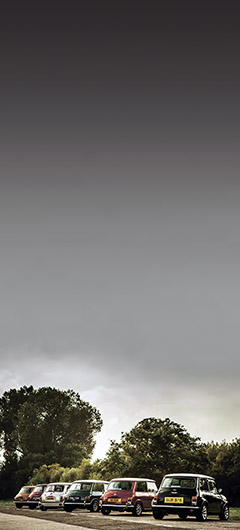
The 1275 GT was the fastest of the Clubman range that was introduced in 1969. Designed by Roy Haynes and Paul Hughes, it moved the model upmarket, replacing the defunct Elf/Hornet while also updating the 1959 alumnus in the face of supermini competition. It boasted better crash protection and a more comprehensive, ergonomic dashboard, but that boxy Maxi-enstein nose did look incongruous. Compare and contrast the Coopers and the 1275 GT in chronological order, and the differences are notable. Don Mitchell’s featured MkI feels roomier, lighter (in both senses) and less refined – that lower final drive (3.765:1 versus the 3.44:1 of the ‘S’ and 1275 GT) highlighting the frenetic nature of the 997cc unit.
Inside, you’re never alone with the heckling from the A-series overdubbed with the unmistakable scream of its idler gear. Accelerate, do your best with the gristly four-speed gearchange and you’re awash with gruff noise.
The large two-spoke wheel scarcely needs any noticeable manual input to navigate gentle flowing roads. Indeed, such is the steering’s gearing and lightness that it feels as if you are tackling snaking complexes via telekinesis rather than expending physical effort. It doesn’t matter that it rides like a runaway ping-pong ball. The waspish turn-in, bountiful grip and free-flowing torrent of feedback with little roll compensates aplenty. Getting reacquainted with a Mini is as easy as blowing dust off a favourite book.
Free from the threat of daydreaming drivers in stop-on-a-sixpence moderns – when the MkI’s unassisted brakes will not be pleaded upon to come to the rescue – the Cooper is all about building, maintaining and dancing with speed. It is this that is one of the biggest differences between the 55bhp MkI and Nick Hunter’s wonderfully original 52,000-mile MkII ‘S’.
The black interior, 130mph speedo, chunky sports wheel and column-mounted pod tacho all suggest a more serious drive. The servo-assisted brakes and greater mid-range muscle deliver on that promise. Hunter’s car has been modified to include front dampers and larger rear bumpstops – not for this Mini the two-fold Hydrolastic blight of rebound float and pitching under braking. Instead, the ‘S’ remains a rapid, blissful way of flinging oneself through the countryside. Pass 3000rpm, where peak torque is produced, and reach for 6000rpm. Its greater performance and slightly quicker, heavier steering really up the intensity of its rewards in relation to the 997.
Not so Terry Harrison’s 1972 Mini 1275 GT, a car that feels less punchy, less frenetic and more mass-market. Gone is the round-nose view ahead, as are the original interior and doors – those thicker vinyl seats, wind-up windows and internal hinges all doing their bit to chomp away at the Coopers’ squash-court roominess. The three-spoke wheel and three-clock dashboard certainly don’t lack charm – even if it’s more cosmic ’70s than groovy ’60s – but Leyland has done its darnedest to cut costs. Only the instrument graphics prevent the vinyl interior from being damnably dismissed as a coal-hole.
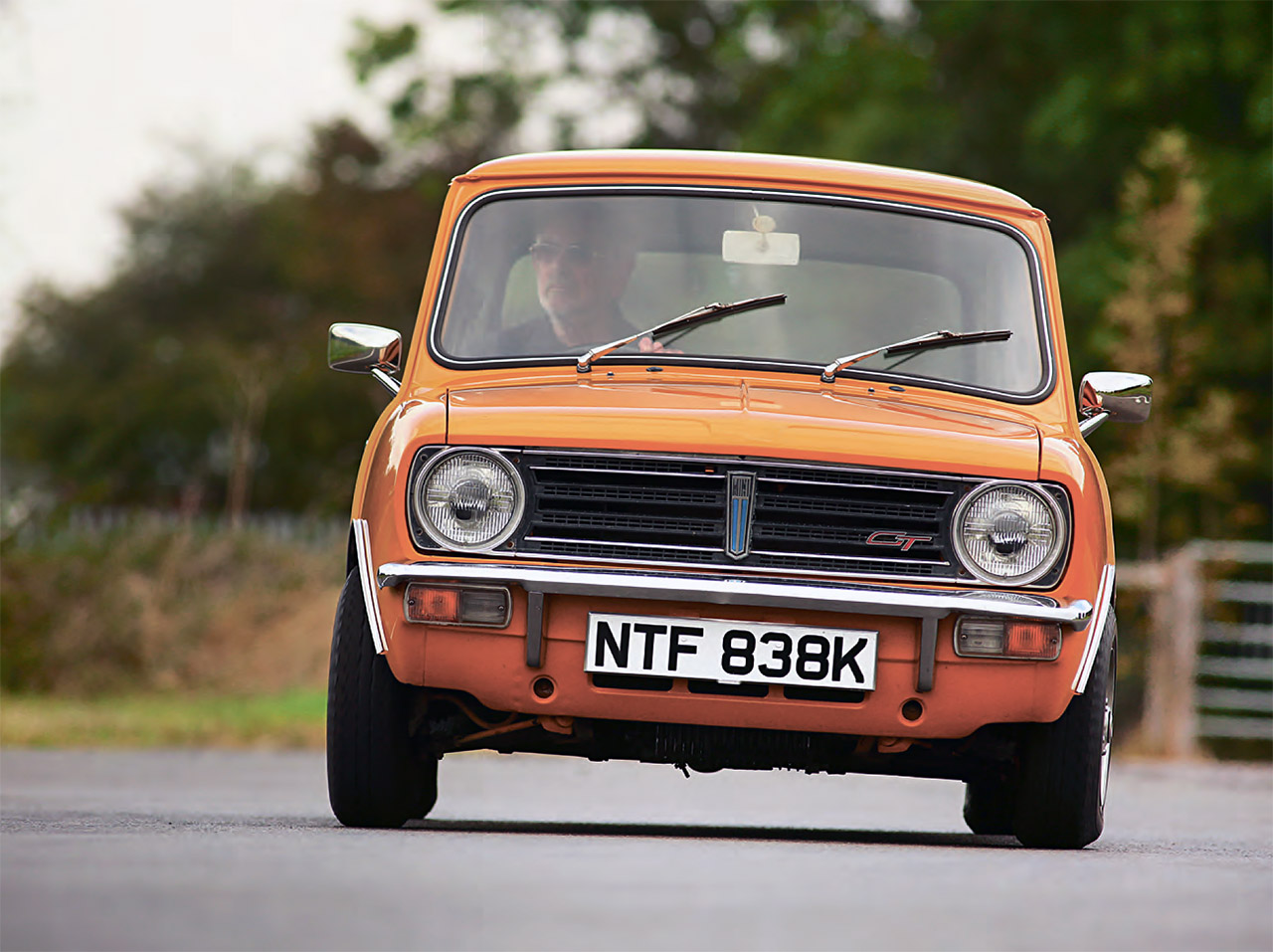
Clubman’s squarer front end arguably lacks the charm of standard model. Below: only 59bhp for single-carb A-series; cabin is gloomy but better appointed; 145 SR10 tyres and simple badge.
Over enticing roads, the 1275 GT’s relative lack of power and torque, plus higher final drive, combine to make this Mini feel more laid back and less feisty. As the engine thrums and tappets jig – the tacho is on strike, comrades – the conesuspended 1275 GT just doesn’t have the Coopers’ sharp-toothed cornering edge. Packing an all-synchro ’box and carrying less hubbub and commotion, this go-faster Mini is a more mature, calmer all-rounder.
Although Leyland Special Tuning could provide owners with a Sports Performance Kit with enough ginger to overcome its sparkle deficiency, the 1275 GT could not replace the ‘S’ in the public affection. Come 1980, the Clubman would make way for the Mini Metro.
Quick-Mini enthusiasts had to endure nine years of abstinence before Engineering Research and Application Ltd (as ERA had been renamed in the 1950s) provided a car to feed their need. Based on a partially built Mini City supplied by Rover and modified by ERA prior to assembly, the Turbo is a quintessentially ’80s interpretation of a Cooper ‘S’ successor. Bearing a bodykit designed by Dennis Adams of Marcos fame, plus the 94bhp A+ engine from the Metro Turbo, the 30-year-old saloon was punted from 0-60mph in 7.8 secs and on to a claimed 115mph.
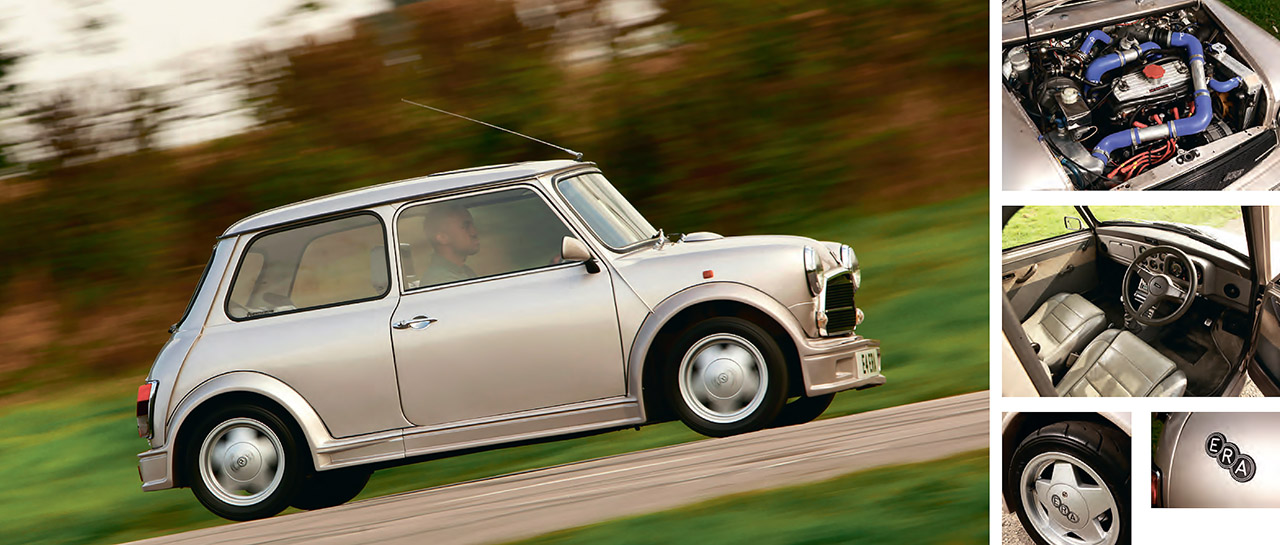
Bonkers bodykit attempts to inject muscle into the Mini outline. Below: turbocharged A+ engine has been tweaked on featured car; a very 1980s interior; alloy wheels; famous three-disc badge.
Ensuring that the ERA’s handling would remain uncorrupted and Mini-ish, the suspension was modified and lowered, and there were Metro brakes plus 6J x 13 alloy wheels. The ERA featured an improved driving position, too, with a Connolly leather-trimmed interior and bespoke dash, wheel and seats to bolster the car’s sense of plush refinement – and, perhaps, to justify a price that trespassed onto hot-hatch territory. Available through selected Rover dealers, the ERA tapped into Japan’s blossoming Mini romance – an affair that would not only keep the car in production but encourage Rover and John Cooper to resurrect their offspring.
Meetings between Longbridge and Cooper – who had developed a successful dealer-fitted twin-carb conversion for the Mini 1000 – led to the idea of fitting a lead-free, catalysed version of the MG Metro’s single-carb 1275cc A+ into the Mini. The development work was undertaken by Rover Special Products, and the reborn Cooper was launched in July 1990 as a ‘Commemorative’ (or ‘RSP’) limited edition of 1000 UK cars, plus a further 650 for Japan. History would be repeated because these figures were not enough to quench demand, and the Commemorative model was replaced by the slightly de-specified ‘Mainstream’ Cooper, which became a permanent addition to the range. The most obvious difference between the two is the loss of the John Cooper-signed bonnet stripes, the red leather steering wheel, sunroof and colour co-ordinated wheelarch trims for the 12in wheels. Later in 1991, the Cooper lost its SU carb in favour of single-point fuel injection.
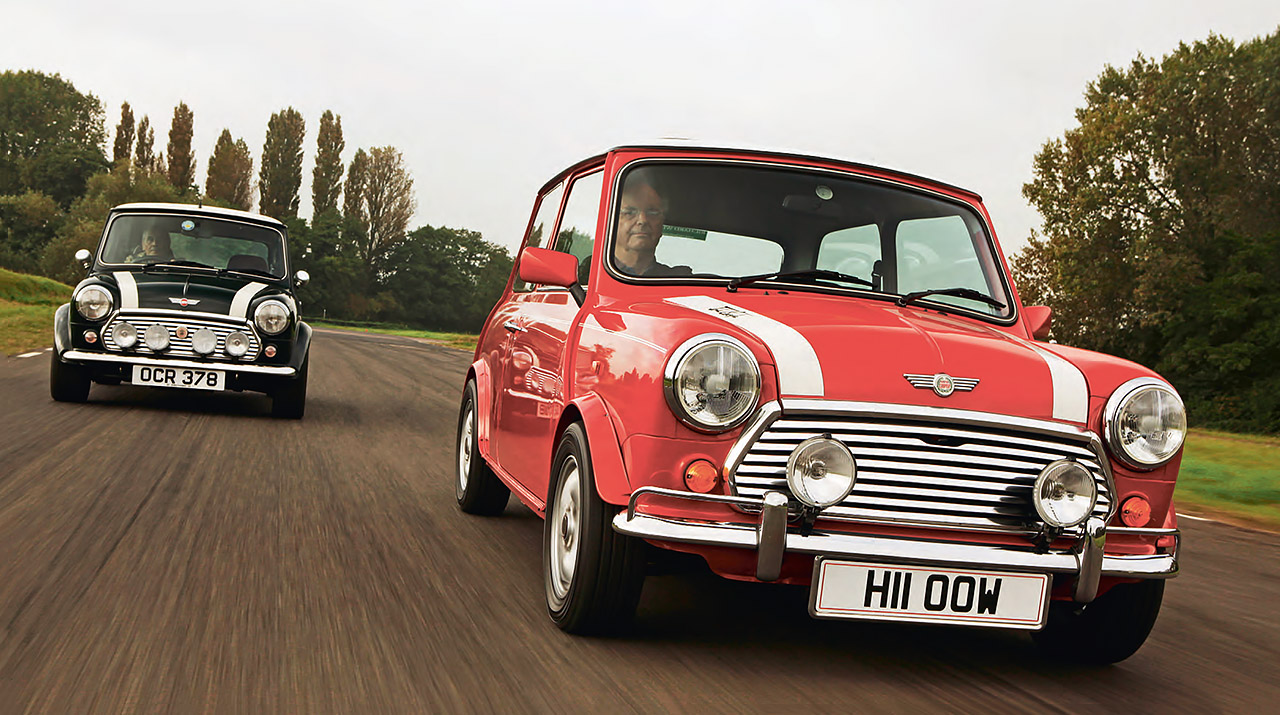
Rover Coopers blend modern usability with old-school entertainment. Below right: carbs for RSP (on right) but injection for S Pack LE; note airbag on later car; Cooper name returned in the 1990s.
In 1996, the Cooper inherited the last of the Mini’s improvements, when the MkVI became the MkVII. Notables included multi-point fuel injection, a front-mounted radiator, full-width dash, driver’s airbag and optional Tonka-esque 13in ‘Sportpack’ alloys. Both single-point and multi-point injected Coopers would sire a host of limited-edition variants, before the end for the quick Mini came in 2000.
Ricky O’Hara’s featured ERA Turbo is the third prototype – it went to Jack Knight for experimental engine and gearbox testing – and is the earliest-known survivor. Modified by its previous owner, it is fitted with a high-boost 1293cc MED engine that boasts a charge-cooler, plus steel springs, upgraded brakes, a Jack Knight straight-cut gearbox, a KAD quickshift and limited-slip differential.
Inside, the ERA is as plush as it is ’80s – an impression reinforced by the grey leather trim, which is very ‘M&S slip-on loafer’. It currently produces 140bhp with 12psi of boost (170bhp is possible with 22psi), which represents a healthy increase over the factory’s 94bhp, and O’Hara advises that it should be driven hard.
Approaching 4000rpm, the ERA’s power delivery has all the subtle progression of Frank Spencer experiencing ‘a spot of bother’ with a bazooka. Go for extended acceleration on the stiffer throttle and your eyes will widen when a front tyre snaps at a drain cover or a chunky road marking. It should put you off, but it doesn’t – for by then you are already addicted to boost.
‘AT HIGHER REVS, THE ERA’S POWER DELIVERY HAS ALL THE SUBTLETY OF FRANK SPENCER’
The ERA is a surround-sound hoot. Its turnin is not as pure and true as its lesser-shod brethren, but in isolation the ERA negotiates a convincing truce between the argumentative demands of furious torque and unfussed straight-line acceleration. On the over-run, the orchestra of shrieking straight-cut gears, sneezing dump-valve and screaming idler gear strikes up a disjointed, scratchy, psychedelic cacophony. Anything that follows the ERA should be as disappointing as returning to work after a fortnight of sun, sea and shandy, yet Bob Needham’s 1991 RSP ‘S’ Pack is anything but. One of 78 conversions carried out by John Cooper Garages for the not-inconsiderable sum of £2900, the 80bhp Rover-supported Janspeed kit included a flowed cylinder head, sports exhaust system, twin HS2 carburettors and high-lift rockers, plus a 3.44:1 final-drive ratio (RSP 3.1:1), a damper/tyre handling pack, and a host of cosmetic flourishes and badges.

Janspeed’s top-end has transformed the A+. It euphorically zings around the tacho emitting a cheeky, fruity exhaust parp. Its Metro gearbox proves a revelation – changing positively, lightly and consistently from one ratio to the next without any four-lettered encouragement. The 12in wheels don’t get distracted by surface imperfections, while corners are casually tossed into the past with Cooper ‘S’ zeal – plus the added benefit of less noise and a better ride. It’s a very resolved blend of ‘S’ capability and 1275 GT usability. Peter Farley’s 1999 car is the 15th of only 25 LEs that were converted into S Pack spec by John Cooper Garages. The interior and the 6J x 13in wheels are the obvious changes, hinting at the ‘boutique’ direction in which its bigbottomed successor would take the Mini name.
Refinement is this car’s key quality. The greater torque from the MPI engine allowed the use of a higher 2.76:1 final drive to make it a quieter cruiser – although the deep sports exhaust is far from shy and retiring. A front-end pedant could moan about the wider wheels having a slightly detrimental effect on this, that and t’other – but the steering is lighter than that of the ERA and I suddenly find myself having daily runabout ideas. After all, this Mini even has side-impact bars and an airbag.
A decision has to be made. In truth, any of these wheeled elixirs would merrily tickle the most jaded of drivers, but with its ‘stop and go’ performance, unadulterated handling, roominess and 1960s décor – glazed with a glimmer of uncouth glee – it is the Cooper ‘S’ that edges it, and blows my bloody doors off. Damnation! Talk about falling at the final hurdle.
Thanks to The Mini Cooper Register: minicooper.org; Curborough sprint course: www.curborough.com; Gerard Hughes.
Competition beginnings
The Mini’s first race happened during its press launch at Chobham’s Fighting Vehicles Research and Development Establishment, when a combination of journalists’ inquisitiveness and sharp-elbowed egos discovered just how quickly a Mini would lap the facility’s test circuit. Not surprisingly, racer-cum-scribbler Paul Frère came out on top in that inaugural scrap.
Just weeks after the official unveiling on 26 August 1959, BMC’s Competitions Department entered an Austin Seven into its first international event, the Viking Rally. Marcus Chambers and Peter Wilson finished 51st overall. That humble result kick-started the Mini’s rally career. In October, Patricia Ozanne and Anne Shepherd entered a Mini-Minor on the German Rally, while Pat Moss and Stuart Turner got the ball rolling with a win on the Mini Miglia National Rally.
Before the start of the 1960 racing season, Arden launched a £38 5s performance conversion for the 848cc Seven and Mini-Minor, featuring twin SU HS2 carburettors and a reworked highercompression cylinder head. The Autocar recorded a 0-60mph sprint of 20 secs (down from 26 secs) with top speed increasing from 74mph to 85mph. Downton Engineering, eventually the most influential and capable Mini tuner, would follow suit alongside the likes of Yimkin Engineering et al.
At the BRDC’s International Production Touring Car Race at Silverstone on 14 May, when drivers such as Stirling Moss, Roy Salvadori and Graham Hill were battling in 3.8-litre Jaguar Mk2s, the Minis were scrapping for a class podium finish. Behind Sigurd Isacson’s Auto Union 1000 came George ‘Doc’ Shepherd and John Aley in Morris Mini-Minors.
By the time that Shepherd was driving a Seven in July’s Production Touring Car Race at the same circuit (above), something had changed. As Bill Boddy of Motor Sport observed: ‘Shepherd’s remarkable Seven passed Jaguars and Fords outside and inside on the corners with impunity’. Issigonis’ tiny revolution hadn’t just found its feet, it was precociously evolving into a motorsport giant.
| Car | Morris Mini Cooper Mk1 |
Cooper ‘S’ MkII |
MINI 1275 GT |
MINI ERA TURBO |
Rover Cooper S-Pack |
Mini John Cooper Le S Works |
|
Sold Number built |
1961-1964 24,860 (including Austins) |
1967-1970 6329 (including all Austins) |
1969-1980 110,673 |
1989-1991 436 |
1990-1991 78 (out of 1650 RSPs) |
1999 25 (300 John Cooper LEs) |
| Construction | all-steel monocoque with subframes f/r | |||||
| Engine |
all-iron, overhead-valve 997cc ‘four’, twin SU HS2 carburettors |
1275cc |
1275cc, single SU HS4 carburettor | 1275cc A+, single SU HIF44 carburettor, Garrett T3 turbo | 1275cc, twin SU HS2 carburettors, Janspeed top-end | 1275cc, multi-point fuel injection |
| Max power | 55bhp @ 6000rpm | 75bhp @ 5800rpm | 59bhp @ 5300rpm | 94bhp @ 6130rpm | 77bhp @ 6000rpm | 90bhp @ 6000rpm |
| Max torque | 54lb ft @ 3600rpm | 80lb ft @ 3000rpm | 67lb ft @ 2550rpm | 87lb ft @ 3600rpm | 78lb ft @ 3250rpm | 88lb ft @ 3000rpm |
| Transmission | four-speed, three-synchromesh manual |
all-synchromesh post-October 1968 |
four-speed all-synchro manual | |||
| Drive | driving front wheels | |||||
| Suspension: | ||||||
| front | independent, at front by unequallength wishbones | interconnected Hydrolastic displacers f/r with rear helper coil springs | Hydrolastic pre-’71, rubber cone springs post-’71 | |||
| rear | trailing arms; rubber cone springs, hydraulic telescopic dampers f/r | |||||
| Steering | rack and pinion | |||||
| Brakes | discs/drums | discs/drums, with servo | vented front discs, four-pot calipers, servo powered | |||
| Wheels | ||||||
| Length | 10ft ¼ in (3054mm) | 10ft 4 ½ in (3165mm) | 10ft ½ in (3061mm) | |||
| Width | 4ft 7 ½ in (1410mm) | |||||
| Height | 4ft 5 ½ in (1346mm) | |||||
| Wheelbase | 6ft 8 ¾ in (2032mm) | |||||
| Weight |
1315lb (597kg) |
1435lb (651kg) | 1488lb (675kg) | 1456lb (661kg) | 1556lb (706kg) | 1576lb (715kg) |
| 0-62mph | 17 secs | 11 secs | 13.3 secs | 7.5 secs | 9.9 secs | 8.9 secs |
| Top speed | 85mph | 97mph | 90mph | 112mph | 100mph | 101mph |
| Mpg | 27-35 | 28-34 | 31 | 34 | 35 | 37 |
| Price new | £679 | £719 | £834 | £11,950 | £11,237 (£8337 RSP) | £12,495 (basic S Works) |
| Value now |
up to £20,000 |
£30,000 | up to £15,000 | up to £40,000 | up to £17,500 |
up to £17,500 |
{CONTENTPOLL [“id”: 21]}





